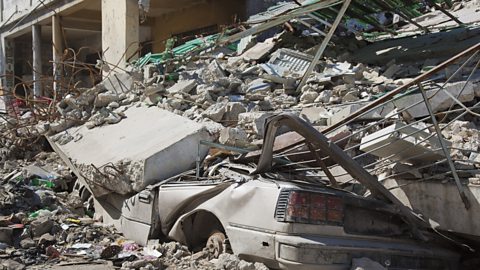Characteristics of volcanoes
- A volcanoA volcano is a vent in the ground which is caused by the upward movement of magma through cracks in the rock. is formed by eruptions of lava and ash.
- Volcanoes are usually cone shaped mountains or hills.
- When magma reaches the Earth's surface it is called lava. When the lava cools, it forms rock.
- Volcanic eruptions can happen at destructive plate marginThis happens where crustal plates move together and one is forced beneath the other. and constructive plate marginAn area where two tectonic plates are moving away from one another. but not at conservative plate marginAreas between two crustal plates that are moving past each other in opposite directions or at different speeds. or collision zoneA collision zone is where two continental plates move towards each other - this can cause fold mountains and earthquakes. .
- Some volcanoes happen underwater, along the seabed or ocean floor.
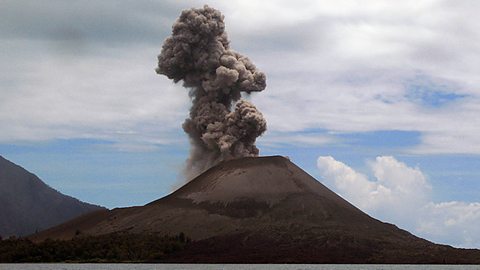
- Magma rises through cracks or weaknesses in the Earth'scrustThe thin layer that is the outermost section of the earth. It varies from between 5 ÔÇô 70 km in depth and is broken up into several large pieces of rock which are known as plates..
- Pressure builds up inside the Earth.
- When this pressure is released, eg as a result of plate movement, magma explodes to the surface causing a volcanic eruption.
- The lava from the eruption cools to form new crust.
- Over time and after repeated eruptions, the rock builds up to form a volcano.
Cross section of a volcano
The diagram below shows how magma pushes up between the two plates:
- The magma chamber is a collection of magma inside the Earth, below the volcano.
- The main vent is the main outlet for the magma to escape.
- Secondary vents are smaller outlets through which magma escapes.
- The crater is created after an eruption blows the top off the volcano.
An eruption occurs when pressure in the magma chamber forces magma up the main vent, towards the crater at the top of the volcano.
Some magma will also be forced out of the secondary vent at the side of the volcano.
Shield and composite volcanoes
Volcanoes can be described in terms of activity and can be:
- still active and erupt frequently;
- dormant (temporarily inactive but not fully extinct);
- extinct (never likely to erupt again).
Volcanoes can also be described by their shape or type - shield volcanoA volcano that is usually found at constructive plate margins as it is formed by thin, runny lava and will have a gentle slope. or composite volcanoA volcano that is usually found at destructive plate margins as it is formed by lava and ash or pyroclastic flows. It will have steep sides..
- Shield volcanoes are usually found at constructive plate margin/boundaryThis is the place where two tectonic plates meet. .
- They are low, with gently sloping sides.
- They are formed by eruptions of thin, runny lava.
- Eruptions tend to be frequent but relatively gentle.
- Example: Mauna Kea in Hawaii, USA or the Galapagos islands
- Composite volcanoes are made up of alternating layers of lava and ash (other volcanoes just consist of lava).
- They are usually found at destructive boundaries.
- The eruptions from these volcanoes may be a pyroclastic flow rather than a lava flow. A pyroclastic flow is a mixture of hot steam, ash, rock and dust.
- A pyroclastic flow can roll down the sides of a volcano at very high speeds and with temperatures of over 400┬░C.
- Example: Hekla in Iceland, Mt St Helens in the USA and Mt Kilimanjaro in Tanzania.
Supervolcanoes
A supervolcanoA massive volcano that could erupt over 1000km3 of material forming a deep caldera with a ridge of land around it. is a volcano on a massive scale. It is different from a volcano because:
- it erupts at least 1,000km3 of material, in comparison a large volcano erupts around 1km3;
- it forms a depression, called a calderaA cauldron / depression shaped tectonic feature usually formed from the collapse of a magma chamber. (a volcano forms a cone shape);
- often has a ridge of higher land around it;
- erupts less frequently - eruptions are hundreds of thousands of years apart.
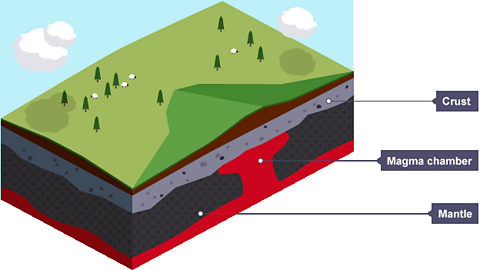
Image caption, The stages in the creation of a supervolcano caldera
Image caption, The stages in the creation of a supervolcano caldera
Image caption, The stages in the creation of a supervolcano caldera
Image caption, The stages in the creation of a supervolcano caldera
1 of 4
Case study: Yellowstone
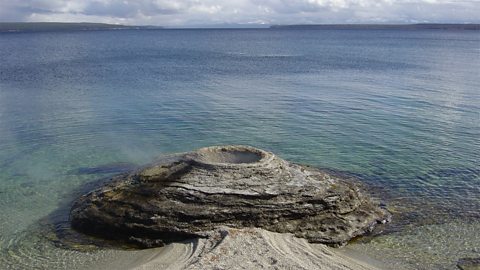
Yellowstone is one example of a supervolcano. Three huge eruptions have happened in the last 3 million years.
The last eruption was 630,000 years ago, and was 1,000 times bigger than the Mount St Helens eruption in 1980.
The large volume of material from the last Yellowstone eruption caused the ground to collapse, creating a depression called acalderaA cauldron / depression shaped tectonic feature usually formed from the collapse of a magma chamber. . The caldera is 55 km by 80 km wide.
The next eruption is predicted to have catastrophic worldwide effects.
The supervolcano at Yellowstone is formed because of a volcanic hotspot.
Every year millions of visitors come to see the related features, such as geyserA spring of water which has been heated geothermally which erupts intermittently. and hot springs. Old Faithful is one example of a geyser.
Potential global impact of a supervolcano
If a supervolcano was to erupt there would be a global catastrophe.
| Potential impacts on people | Potential impacts on the environment |
|---|---|
| Death and destruction In North America over 100,000 people will be killed instantly due to the blast and pyroclastic event. Breathing ash will kill millions more over time. | Ejecta A supervolcano eruption would make most of North America uninhabitable as huge amounts of ejecta would be thrown into the atmosphere. This could include a 40km high ash cloud. |
| Ash clouds would migrate across the globe, reaching the UK in 5/6 days. Ash falls would bury the soil, clog up machinery, and cause respiratory health problems for people. Lahars, destructive volcanic mudflows, where ash mixes with water in river valleys, would devastate whole communities. | Ash The ash thrown into the upper atmosphere will circulate around the globe and could cause a ÔÇÿdark summerÔÇÖ ÔÇô where no sunlight gets through for at least one year. Global temperatures could drop by 3 ÔÇô 5 degrees and remain low for many years. |
| Food supply - Crops and food supplies would suffer hugely and prices would increase dramatically. Global famine and mass starvation would be inevitable. | Climate change Such an eruption would spark climate change that might trigger a mini-ice age. This would be due to the 2 billion tonnes of sulphur dioxide gas thrown into the atmosphere where it would reflecting away solar radiation. |
| Changing a way of life Homes would be destroyed; air, road and rail travel and transport would grind to a halt, water supplies would be contaminated ÔÇô life as we know it would change radically and survival would become increasingly difficult. | Ecosystem destruction - Within 100km whole ecosystems would be destroyed. Vegetation would be wiped out disrupting habitats and food webs. Animals would die due to respiratory problems and starvation. Yellowstone is home to 10 - 20 thousand elk and many other species including bison, wolves and brown bears. |
| Water supplies would be contaminated by ash and sulphur, becoming undrinkable. | Natural vegetation- It would take at least 10 years for vegetation to be re-established close to the eruption zone. |
Activity: Take the test
More on The restless earth
Find out more by working through a topic
- count1 of 4
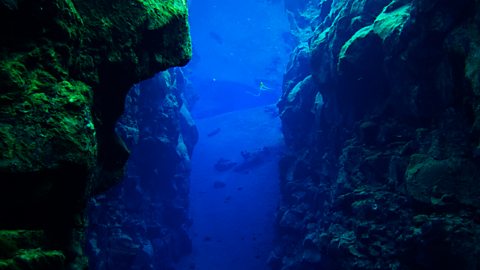
- count2 of 4
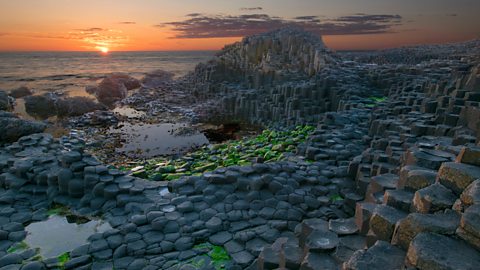
- count3 of 4
